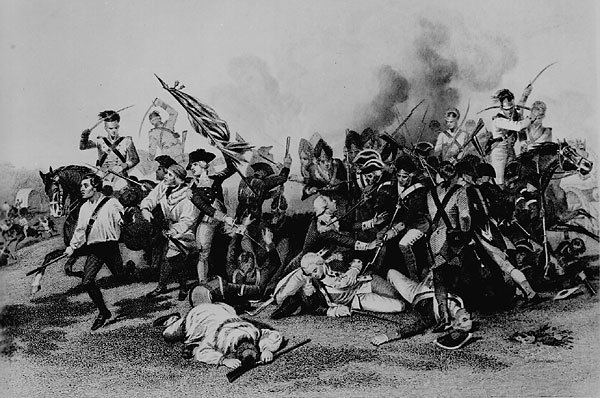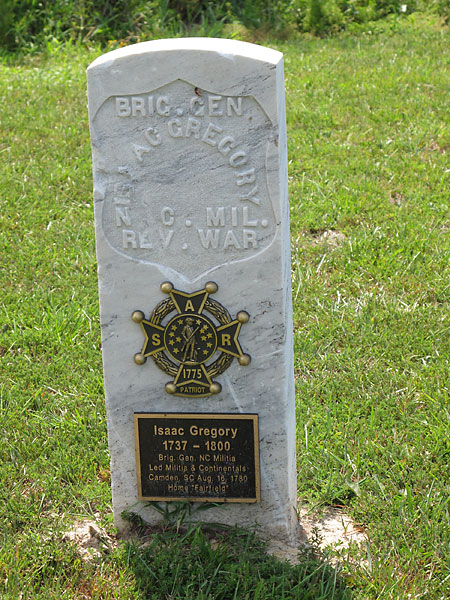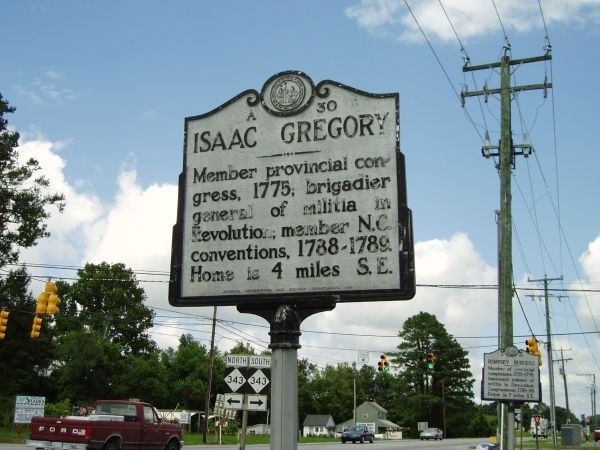Brigadier General Isaac Gregory
- Details
Brigadier General Isaac Gregory
“To Camden folk, Isaac Gregory is the most dignified figure who has played a part in their history—partly because of the somewhat impressive surroundings into which he was born, but more largely because of his own rather austere bearing. The lighter touch at least was not one of his immediately apparent characteristics. And if his painstaking habits and ponderous actions tended to add to the impressiveness of his personality, by the same token they also helped to make of him a controversial individual. His deliberation, for example, could at times be a source of exasperation to his associates.”
A Camden County Hero

Across the road from a cornfield stands a small monument to Gen. Isaac Gregory. Inscribed are the dates of his birth and death: 1737 and 1800.
It says nothing, though, about his bayonet charge into the British troops of Lord Charles Cornwallis, that he was nearly killed or later falsely accused of treason based on an enemy prank.
At the Battle of Camden, SC, on April 16, 1780, General Isaac Gregory and his North Carolina militia stood against a charge of superior British forces while other militia ran. (Courtesy of National Archives)
Daughters of the American Revolution first set the marker some 100 years ago in front of the Gregory home. It was knocked down in the 1970s and forgotten.
But Gregory's descendants and others know of Gregory's heroics. They will honor the general who years ago led his inexperienced North Carolina militia into brutal hand-to-hand combat with some of the best-trained troops in the world.

Gregory was born in Pasquotank County, where he served as a sheriff, a militia colonel and a representative in the last General Assembly to meet under a royal governor.
In 1777, Pasquotank County was divided at the river forming the new county of Camden and included Gregory's home and property. He was appointed to a committee that established the courthouse in the new county. After the war, he represented Camden in the state's House of Commons and in its Senate.
"He was the most notable person to have ever lived in Camden County," said local historian Alex Leary.
On Aug. 16, 1780, a 43-year-old Gregory led a North Carolina militia at the Battle of Camden, S.C., under the overall command of Gen. Horatio Gates, the hero of Saratoga, according to several accounts, including the Encyclopedia of the American Revolution and the North Carolina Office of Archives and History.
Commanded by Lord Charles Cornwallis, the British forces charged the Americans, causing many of the militia units to flee. Gates fled with them and was later blamed for the resounding defeat where about 900 Americans were killed or wounded and 1,000 captured.
Despite the loss, there were acts of bravery by the Americans, in particular those of Gregory.
At the battle's worst, Gregory's men joined a charge with Continental regiments from Maryland and Delaware into the oncoming British. Gregory's horse was killed, pinning him to the ground. British soldiers bayoneted him twice as he lay there. He was captured, but British doctors released him when they thought he was dying. Cornwallis even recorded him as among the American dead.
Gregory recovered to lead a militia to protect northeastern North Carolina from a possible invasion of the British from Suffolk, according to the Dictionary of North Carolina Biography.
The British did make forays into the region. On one occasion, a British officer left behind a note as a prank saying Gregory was a traitor and may betray American troops. American forces found the note and Gregory was charged with treason.
The British officer heard about the charges and sent a letter explaining his prank. The case never went to court, but Gregory was hurt by the lack of trust in him.
"He never forgot that," Leary said.
After the war, Gregory ran a plantation called Fairfield where he built a 3-story brick mansion and had a family of six children. He died at the home and was buried there in 1800 at the age of 63. There is no sign of his grave.
The brick home was occupied until about the 1950s and stood for 30 more years until its remnants were torn down into a pile of bricks, said Bess Tillitt Godfrey Sawyer, a descendant of Gregory and owner of much of what was Gregory's plantation. Most of the brick rubble is gone now, too. The only sign is a patch of trees in the middle of a corn field.

The marker also has a story.
The Daughters of the American Revolution set the white 3-foot tall marker some 100 years ago in front of the Gregory home. It was knocked down in the 1970s and lay there until it disappeared for a while before being recovered.
For more than 30 years it stood in a corner of Sawyer's garage. In the spring of 2011, the Sons of the American Revolution had the marker cleaned and a new metal plaque mounted on it with the years of Gregory's birth and death and a note about the Camden battle on it. The marker was reset in a mowed area across from the cornfield where it once sat.
By Jeff Hampton
The Virginian-Pilot
August 14, 2011 CAMDEN COUNTY, N.C.
School Resource Information
- Details
Board of Commissioners
- Ross B. Munro - Chairman
- Tiffney White - Vice Chair
- Tom White
- Randy Krainiak
- Clayton D. Riggs
- Erin Burke - County Manager
- Karen Davis - Clerk of the Board
- John S. Morrison - County Attorney
To whom it may concern:
Thank you for your interest in the History and Culture of Camden County. Below are links to several Camden County historical resources.
Click here for information regarding the following:
- "South Mills" - General History of the Northern Township of Camden County
- "Camden" - General History of the County Seat Township
- "Shiloh" - General History of the Southern Township of Camden County
- "The Historic Camden County Courthouse" - Brief History of the Courthouse
- "Camden - County of Opportunity" - Historical highpoints of Camden County
- "Education in Camden" - Educational History of Camden County
- "Wade Point Lighthouse" - Brief History of Pasquotank River's own Lighthouse
- (lighthouse no longer exists, building was destroyed - see handout for more details)
- "Celebrating a Gateway" - Daily Advance Article from August 9, 2006 about the Floating Road
- "You might be a 'Swampneck'!" - Information about the Dismal Swamp Canal and Welcome Center.
Also check out:
- www.visitcamdencountync.com
- www.dismalswamp.com
- For Civil War History that happened in Camden County, check out the "Battle of South Mills" website
Shiloh Stores
- Details
Below are some pictures of stores that have come and gone in Shiloh Township throughout Camden's history.
Click to Enlarge
Old Trap Stores
Click to Enlarge
Texaco Beach Restaurant & Elizabeth City Beach Restaurant
Both owned by the Cuthrell Family.
Click to Enlarge
Wade Point Lighthouse
- Details
The Wade Point Lighthouse served as the Pasquotank River's sentinel for almost 100 years from 1859 to 1955. The screw-pile lighthouse was a 26 foot square building which rested on 5 steel pilings with the floor about 12 feet above the water's surface. The original lighthouse was destroyed by Confederate guerillas (during the Civil War) on August 3, 1863 and was not rebuilt until after the war. The lighthouse served the Pasquotank River until 1955 when the US Coast Guard decommissioned it and sold it to Elijah Tate from Coinjock for $1.00. The structure was destroyed when it slipped off the barge during a storm into the Pasquotank River. Today the pilings are still visible off Camden Point.
Click to Enlarge
Old Trap, NC
- Details
Raymond Creek Settlement
The first settlers who settled on the north side of the Pasquotank River located themselves along Fleming Creek, currently known as Raymond's Creek. George Fleming established a small residence that was about 12 feet wide and 18 feet long with dirt floors. This took place before the Albemarle Territory was given to eight Lord's Proprietors by Charles II in 1663. The County of Albemarle became the Province of North Carolina in 1689.
By 1700 Fleming Creek became known as Raymond's Creek, named after William Raymond. The Raymond Creek area soon became the most popular community on the northeast side of the river with two places to worship: "Down River Chapel", established by the Anglican Church and the "Baptist Meeting Place", at the mouth of Raymond's Creek established in 1727. [Editor's Note: The 'Baptist Meeting Place' referred to is the 'Shiloh Baptist Church', which was organized by William Burges in 1727. They met at his home for lack of any other place of worship until 1736 when the first Shiloh Baptist Church building was built.].
Click to Enlarge
Old Trap Store
The "Trap" first appeared in Camden records after the Revolutionary War and is said to have been given the name by local women who became irate when their husbands stayed too long at a grogshop (store) on their way to and from the windmill on the river. After 1800 the Trap became known as "Old Trap" and was officially used when the post office opened in 1881.
Click to Enlarge
Brick Store at Old Trap
The brick store at Old Trap was built in 1927 and it was operated by Martin Hubbard, Elroy Pugh, and Jim Burgess. Jim Burgess sold out and it was then operated by Hubbard and Pugh. Elroy Pugh sold out in 1947 and the store was renamed Riggs and Riggs. In 1955 Warren Riggs bought the store but his mother, 'Miss Ellie', continued to operate it until 1961 when Warren took over and became the 'unofficial mayor of Old Trap'.
Even though ownership of the store changed through the years, its purpose remained the same - to provide entertainment for the local men in the community and of course it did provide groceries and daily supplies to households. Card games, dominos, and even pool in the back room, kept the men coming to the store and staying late into the night up until its closing. It was the central spot for communication as men stayed well informed on local gossip, county government, and other political issues facing our state and country at that time. The legacy of 'Old Trap' remained until its final closing in 1997.
Click to Enlarge






